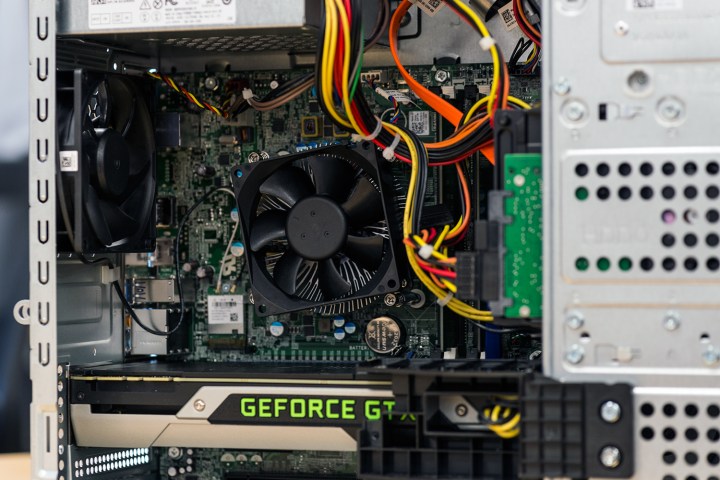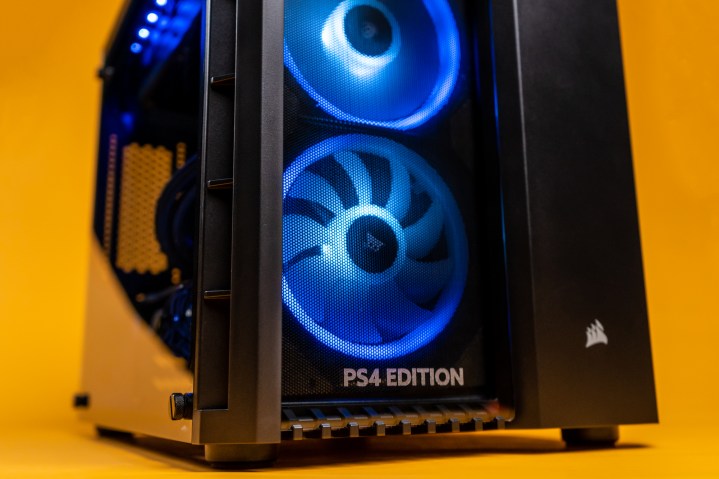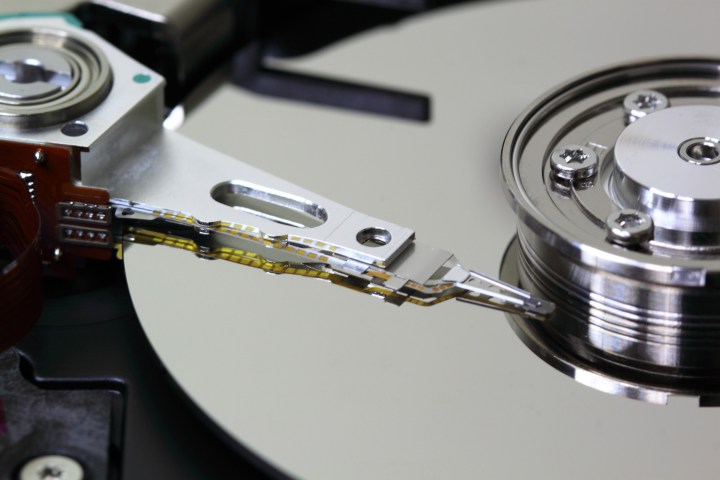
With the correct equipment and a few incantations, most users can exorcise the demon howling in their desktop. Here are some ways to make your computer quieter.
Check fan mounting and dust buildup

Here’s an easy step that almost anyone can do. Carefully remove the side panel of your PC and check all of your attachments. Grommets, gaskets, and screws may all be involved, and if any of them have grown loose over time, they could be vibrating and making your PC far louder than it’s supposed to be.
Check them all, tighten anything that needs to be tightened, and make sure that fans aren’t wobbling or loose. You can even buy mounts that include padding or gel for extra vibration resistance, though that is a step only advanced users will want to take. This a good time to check the base of your computer too, and make sure the feet are rubberized and all on a flat plane to reduce noise.
Also, while you have access to the fan and the back of your PC, don’t forget to clean the whole thing out. Get a soft brush and a can of air, and get rid of any dust you see. That dust can make your computer overheat, as well as make your fan noisier, so a little bit of cleaning really can make a difference. Just make sure you’re blowing the dust out of your computer, not just redistributing it inside.
Finally, before you replace the side panel, make sure that all dust filters and heatsinks are cleaned. Dust causes heat, as does restricted airflow, causing your fans to spin faster and louder. Better cable management results in better airflow, too, which can also help keep your components cooling, meaning your fans don’t need to work as hard.
Add sound insulation
The case is another area where you might find improvement. Many inexpensive computers come in cases that were built without considering acoustics. The case might amplify sound or let it flow freely to your ears.
This problem can be solved with sound insulation. Sound extreme? It’s not. Typical insulation is nothing more than molded foam that can be purchased for between $20 and $60 and stuck inside a PC with adhesive. The foam can be used to plug up unused fan mounts, or layered across the side panels. It’s easy to cut and can be attached with bundled adhesive or two-sided tape from your local hardware store.
There are a couple of downsides to this method, however. First, not all foam is equal. Make sure you use foam that’s meant for electronics. Otherwise, you might find yourself dealing with a house fire.
The other issue is airflow, which may actually increase the noise of your computer. The goal is to find a balance between sound dampening and airflow. A good way to accomplish this balance is to cut small sections of foam and adhere them into your PC case on the side panel, about four or five. It may seem small, but a little goes a long way.
Replace old fans with new versions
A system that is always noisy suffers from bad fans, too many fans, or both. Take a look at what’s inside your desktop. Do you only see one or two fans? Then they’re probably cheap or old and are making more noise than they should.
We have good news and bad news. The bad news is that those fans will need to be replaced. The good news is that fans are cheap! Mostly. Most users will want to look for fans that offer an adjustable speed switch, or ones that support fan speed modulation via a program like SpeedFan. Noctua’s NF-S12B fans, for example, are the best PC fans we’ve found, and they’re around $15 apiece.
Here’s another trick — big fans are quieter than little fans. That may seem strange, but it’s true. Airflow is based on fan size and speed. A big fan doesn’t have to work as hard as a small one to move the same volume of air, and fan speed is the main generator of fan noise. Ideally, you’ll want to use the biggest, slowest fans that can fit in your case.
That’s why too many fans can be a problem. The goal is to move as much air through your PC as efficiently as possible, so adding more fans will not only make your PC louder, it may also have little to no impact on the airflow of your computer. Airflow is a complex topic, and one that’s still being debated amongst PC enthusiasts. However, most agree that it’s best to have a single channel of airflow through your computer. For example, fans in the front of your case will draw in air, while a fan in the back will exhaust it.
In such a situation, a fan mounted on the top of your case that draws in air would make your PC louder without doing much to keep it cooler. This is all highly dependent on your case and components, but in most cases, you don’t need a fan on every mount available.
Remove fans entirely

With new fans installed or extras removed, you’ll want to see how the computer’s cooling performs. SpeedFan can report temperatures as can PC Wizard, Real Temp, and HWMonitor. The processor should idle at no higher than 50 degrees Celsius, and stay below 70 degrees Celsius at load. If you have a graphics card, you should monitor that, too. It should idle below 60 degrees Celsius and stay below 95 degrees Celsius at load.
Add fan controllers or adjust the curve
Adjusting your fans so they don’t spin up as much or only do so when your PC is working hard can really help bring down noise levels. For your CPU and case fans, you can dig into your PC’s BIOS and adjust the fan settings to target higher temperatures or lower noise levels. This may include enabling a smart fan mode that automatically adjusts the fan speeds based on the CPU and overall system temperatures. You may be able to tweak this curve by manually setting specific fan speeds for specific temperatures.
For GPUs, you can use third-party software like EVGA’s Precision X1 or MSI’s Afterburner to adjust the GPU fan curve, though AMD and Nvidia also have their own options built into their drivers.
You can also make use of third-party hardware and software fan control solutions. NZXT’s CAM system or Corsair’s iCUE are controllable through software and connect fans and coolers physically to an interior controller.
There are also external fan controllers with dials and touchscreens, like the NZXT Sentry 3 module, which provides a touchscreen supporting five channels at 15 watts each. It includes five PWM male fan connectors, a temperature sensor, and a Molex power connector. It connects directly to your PC’s fans and power supply. The temperature probe can be taped near the CPU or to nearby heat pipes.
Switch to an SSD

If your SATA hard drive is making a lot of noise when it operates, switching to an SSD will get rid of this noise. Solid-state drives use circuits to store data instead of a disc. There are no moving parts since there is no need to read a disc to retrieve data, which reduces noise. An SSD typically costs more, but the lack of moving parts increases the lifespan of these drives. Swapping your old hard drive for an SSD is also an opportunity to upgrade your computer’s storage space.
The noise mechanical hard drive makes when it’s about to fail earned the nickname “the click of death” for a reason. As a hard drive begins to fail, the read/write mechanism begins to move erratically, often causing damage to the drive’s internal disks as they spin. If your drive is making any unusual sounds, it may be time to replace it and avoid any catastrophic data loss.
What about laptops?

A noisy laptop can be the result of a technical problem, a failing fan, or using your laptop in a manner that restricts the airflow to the vents. If you tend to use your laptop reclining in bed, resting it on your comforter or heavy blanket, airflow can be the culprit. If that’s the case, you’ll just need to change your location.
System fans are a common cause of excessive noise, which will require help from the manufacturer if your machine is under warranty. If your machine is out of warranty, you can also find help at a qualified repair shop. Just check to see that they service your particular brand of laptop, as parts will need to be ordered directly from the manufacturer.
Laptop fans have limited availability in replacement parts, making it harder to reduce the noise. While you can open a desktop case to replace an old fan, it’s more difficult with a laptop. There’s no easy way to take a laptop apart and replace the fan with a quieter, third-party version.
Instead, try a cooling stand. Adding a fan seems counterintuitive, but it will reduce workload. Keeping it off the ground can solve a lot of issues. Most intake vents are on the bottom of a laptop. Instead of resting it on your lap or a blanket, put it on a desk or laptop stand.
External cooling stands are significantly quieter, but they don’t always fix annoying laptop noises.
Editors' Recommendations
- How to take a screenshot on a Mac
- How to change your Zoom background on Mac and Windows
- These are the 10 best gaming PCs I’d recommend to anyone
- The best PC fans
- How much RAM do you need for a laptop, gaming PC, or tablet?


